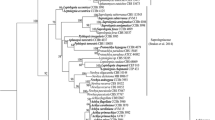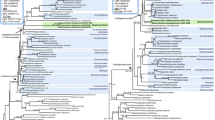Abstract
The aim of this study was to improve our knowledge about the taxonomy and phylogeny of the family Saprolegniaceae, a group of water molds including several pathogens of plants, fish and crustacea. ITS and LSU rDNA were sequenced for representatives of forty species corresponding to ten genera (Achlya, Aphanomyces, Brevilegnia, Dictyuchus, Leptolegenia, Plectospira, Pythiopsis, Saprolegnia, Thraustotheca). Phenetic and cladistic analyses were then carried out. The species Brevilegnia bispora does not appear to belong to the family Saprolegniaceae. Plectospira myrianda clusters with Aphanomyces spp. and they constitute an ancestral group. (Thraustotheca clavata is closely related to the eccentric species of the genus Achlya. The genus Achlya appears polyphyletic, corroborating more or less the three known subgroups, defined by their sexual spore type (eccentric, centric and subcentric). The achlyoid type of spore dehiscence, shared by Aphanomyces and Achlya genera, is shown to be an ancestral character. The saprolegnioid, dictyoid and thraustothecoid types of spore dehiscence are derived characters but their relative evolutionary positions are not resolved.
Similar content being viewed by others
References
Apt KE & Grossman AR (1993) Characterization and transcript analysis of the major phycobiliprotein subunit genes from Aglaothamnion neglectum (Rhodophyta). Ann. Mycol. 7: 441–472
Atkinson GF (1909) Some problems in the evolution of the lower fungi. Mol. Biol. 21: 27–38
Barriel V (1994) Phylogénies moléculaires et insertions-délétions de nucléotides. C. R. Acad. Sci. Paris Sciences de la Vie/Life Sciences 317: 693–701
Coker WC & Matthews VD (1937) Saprolegniales. North. Amer. Flora 2: 15–76
Daugherty J, Evans TM, Skillom T, Watson LE & Money NP (1998) Evolution of spore release mechanisms in the Saprolegniaceae (Oomycetes): Evidence from a phylogenetic analysis of internal transcribed spacer sequences. Fung. Gen. Biol. 24: 354–363
De Bary A & Woronin M (1881) Untersuchuingen über Peronosporeen und Saprolegnieen und die Grundlagen eines natürlichen Systems der Pilze. Beitr. Morph. Phys. Der Pilze 4: 1–145
De Bary A (1888) Species der Saprolegnieen. Bot. Ztg. 46: 599–610, 613–621, 629–636, 645–653
De Kinkelin P, Michel C & Ghittino P (1985) —Précis de pathologie des poissons, INRA-OIE, 348 p
Denis A (1985) Saprolegniales de poissons. Epidémiologie, thérapie, biotaxonomie. Thèse. Université Sciences et Techniques du Languedoc, Montpellier
Dick MW (1969) Morphology and taxonomy of the Oomycetes, with special reference to Saprolegniaceae, Leptomitaceae and Pithyaceae. I. Sexual reproduction. New Phytol. 68: 751–775
Dick MW (1972) Morphology and taxonomy of the Oomycetes, with special reference to Saprolegniaceae, Leptomitaceae, and Pithyaceae. II. Cytogenetic systems. New Phytol. 71: 1151–1159
Dick MW (1973) Saprolegniales and Leptomitales. In: Ainsworth GC, Sparrow FK, Sussman AS (Eds). The Fungi - an advanced treatise, vol IVB (pp 113–158). Academic Press, New York
Dieguez-Uribeondo J, Huang T-S, Cerenius L & Soderhall K (1995) Physiological adaptation of an Aphanomyces astaci strain isolated from the freshwater crayfish Procambarus clarkii. Mycol. Res. 99: 574–578
Felsenstein J (1985) Confidence limits on phylogenies: an approach using the bootstrap. Evol. 39: 783–791
Fisher A (1892) Phycomycetes. Die Pilze Deutschlands, Oesterreichs und Schweiz. In Rabenhorst, Kryptogamen-Fl. 4: 1–490
Forbes EJ (1935) Observations on some British water molds (Saprolegniales and Blastocladiales). Trans. Brit. Mycol. Soc.19: 221–239
Höhnk W (1933) Polyplanetism and zoospore germination in Saprolegniaceae and Pythium. Amer. J. Bot. 20: 45–62
Horton JS & Horgen PA (1989) Polymorphisms in the nuclear DNA of Achlya species: some taxonomic implications. Can. J. Microbiol. 35: 1146–1155
Johnson JR (1956) The genus Achlya. Morphology and taxonomy. University of Michigan Press, Ann Arbor
Larsson M (1994) Pathogenicity, morphology and isozyme variability among isolates of Aphanomyces spp. from weeds and various crop plants. Mycol. Res. 98: 231–240
Liu C & Volz PA. (1976) On the ecology of the Saprolegniaceae. Phytologia 34: 209–230
Molina FI, Jong SC & Ma G (1995) Molecular characterization and identification of Saprolegnia by RFLP of genes coding for ribosomal RNA. Antonie van Leeuwenhoek 68: 65–74
Papatheodorou V (1980) Les Mycoses chez les poissons. Etiologie, pathogénie, traitement. Thèse Institut National Polytechnique, Toulouse
Philippe H (1993) MUST: a computer package of management utilities for sequences and trees. Nucl. Acids. Res. 21: 5264–5272
Powell MJ & Blackwell WH (1998) Phenetic analysis of genera of Saprolegniaceae (Oomycetes). Mycotaxon 68: 505–516
Saitou N & Nei M (1987) The neighbor-joining method: a new method for reconstructing phylogenetic trees. Mol. Biol. Evol. 4: 406–425
Scott WW (1961) A monograph of the genus Aphanomyces. Virginia Agr. Exp. Sta. Tech. Bull. 151: 1–95
Sekino T, Kubota S, Morikawa S, Tashiro F & Komatsu T (1987) Studies on the dynamics of water molds in the ponds of fish farm; Saprolegnia, Achlya, Aphanomyces, Leptolegnia. Bull. Nippon Vet. Zootech. Coll. 36: 70–77
Seymour RL (1970) The genus Saprolegnia. Nova Hedwigia 19: iv–124
Swofford DL (1993) PAUP: Phylogenetic Analysis Using Parsimony Version 3.1, Computer program distributed by the Illinois Natural History Survey, Champaign, Illinois
Thompson JD, Gibson TJ, Plewniak F, Jeanmougin F & Higgins DG (1997) The Clustal X windows interface: flexible strategies for multiple sequence aligment aided by quality analysis tools. Nucl. Acids. Res. 25: 4876–4882
White TJ, Bruns T, Lee S & Taylor J (1990) Amplification and direct sequencing of fungal ribosomal RNA genes for phylogenetics. In: Innis M, Gelfand DH, Sninsky J & White TJ (Eds) PCR protocols (pp 315–322). Academic Press, San Diego
Willoughby LG (1978) Saprolegnias of salmonid fish in Windermere: a critical analysis. J. Fish Dis. 1: 51–67
Author information
Authors and Affiliations
Corresponding author
Rights and permissions
About this article
Cite this article
Leclerc, M., Guillot, J. & Deville, M. Taxonomic and phylogenetic analysis of Saprolegniaceae (Oomycetes) inferred from LSU rDNA and ITS sequence comparisons. Antonie Van Leeuwenhoek 77, 369–377 (2000). https://doi.org/10.1023/A:1002601211295
Issue Date:
DOI: https://doi.org/10.1023/A:1002601211295




